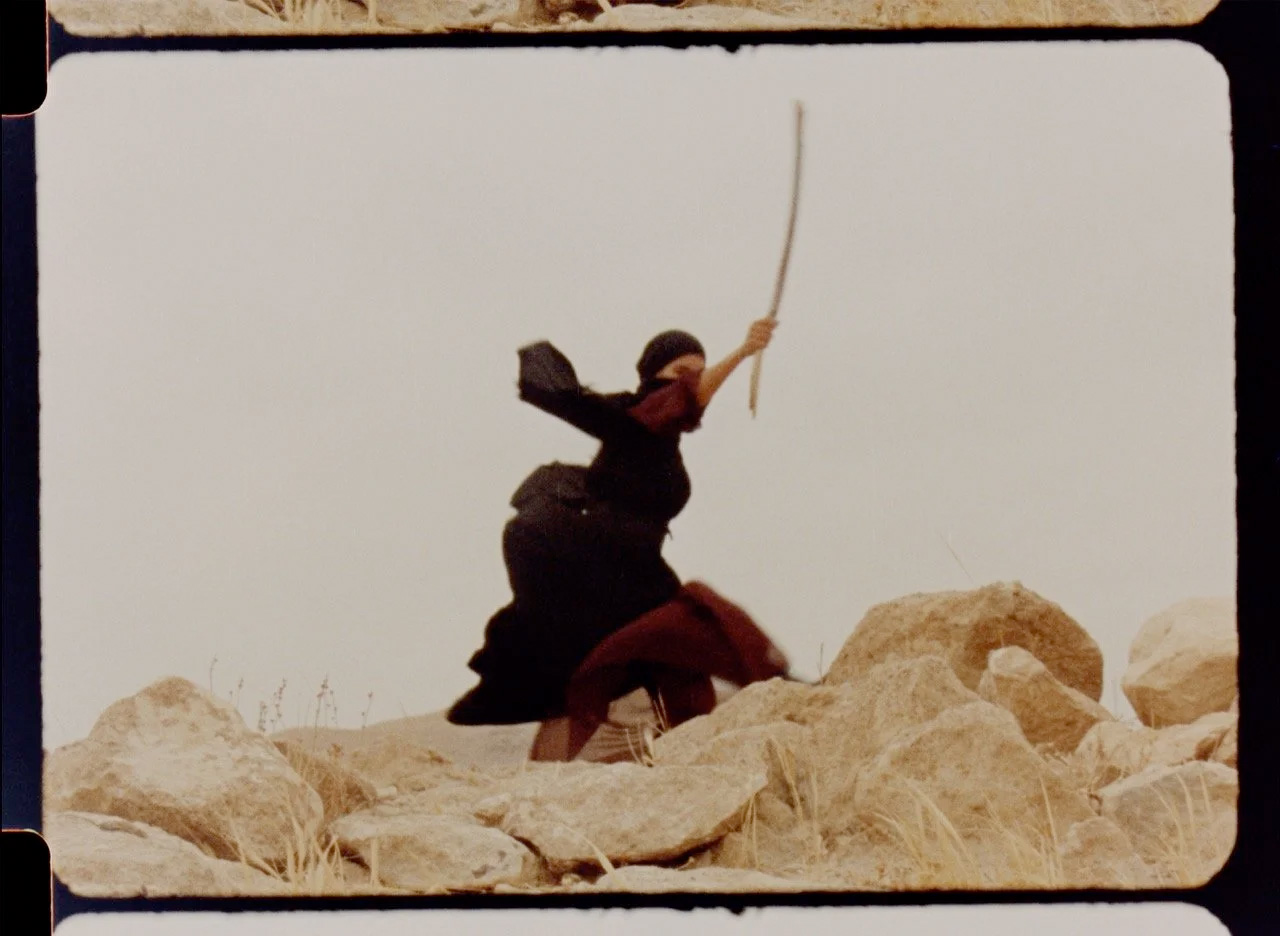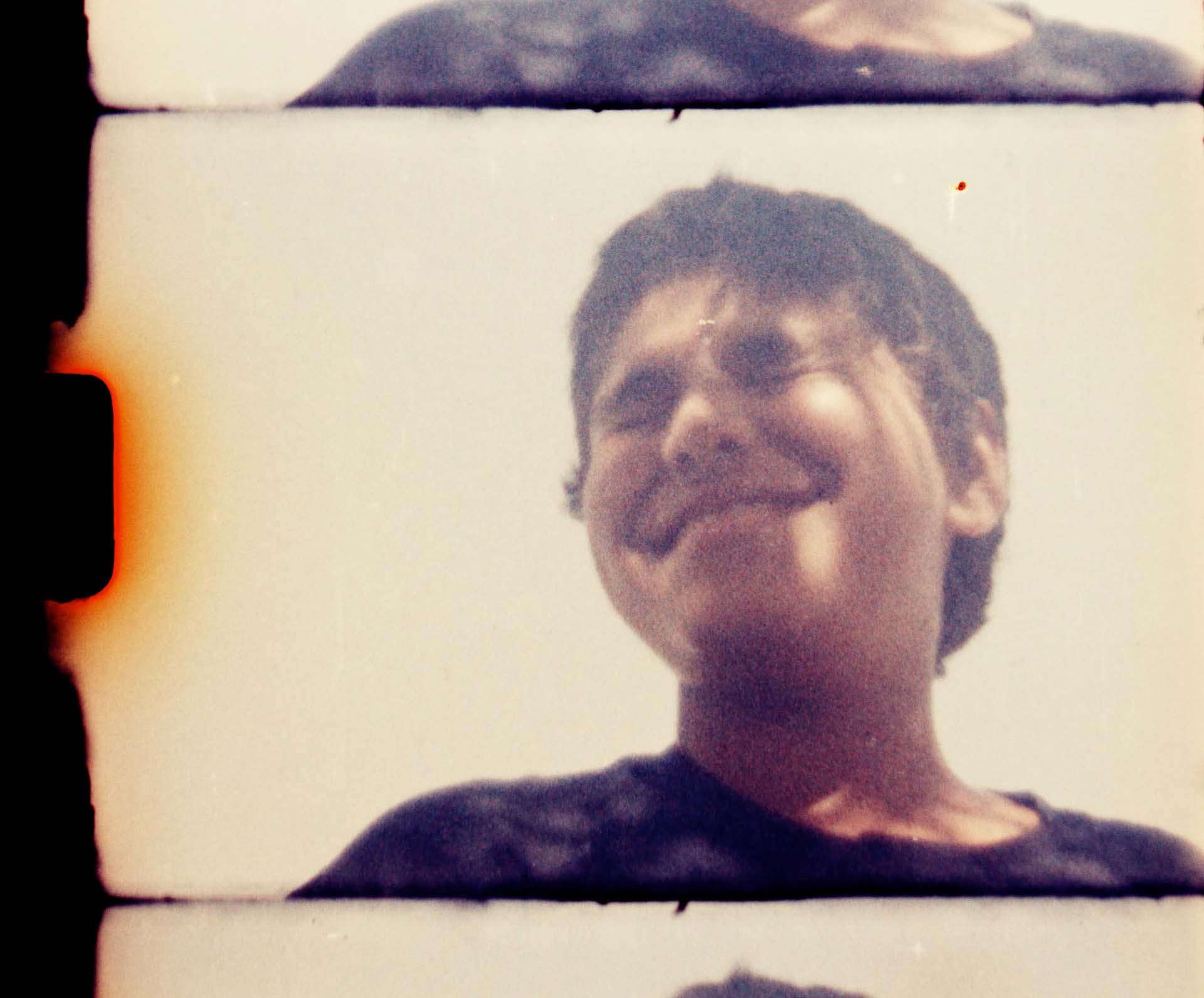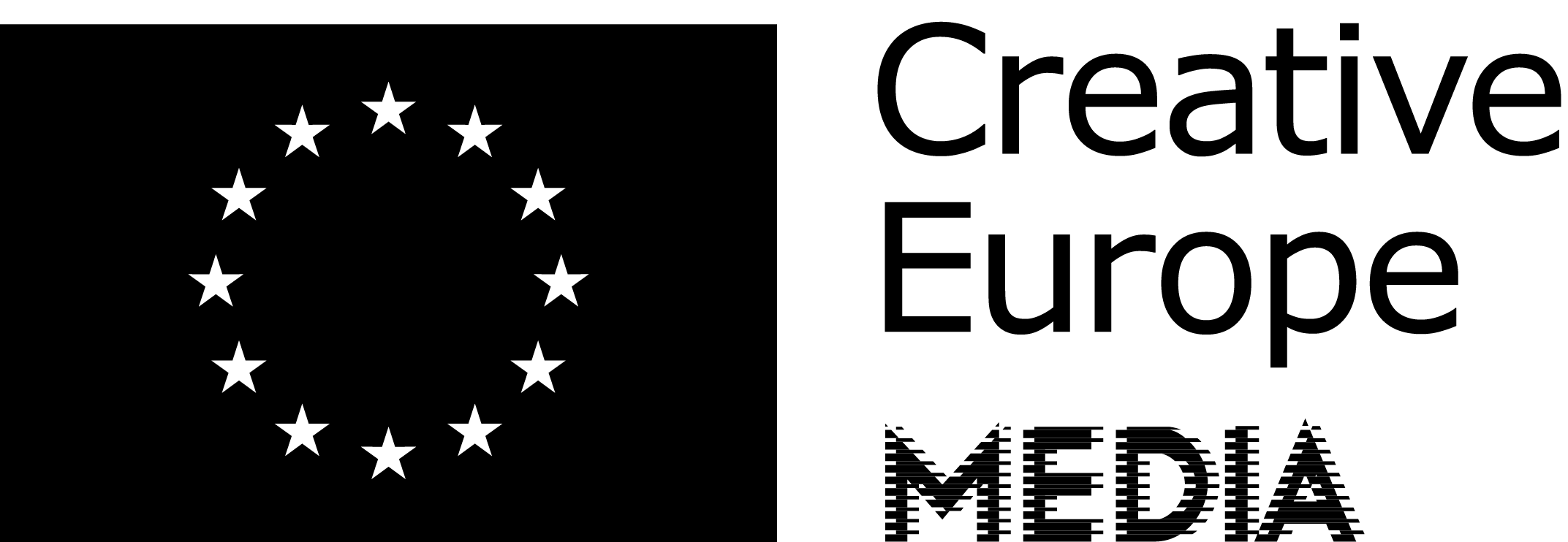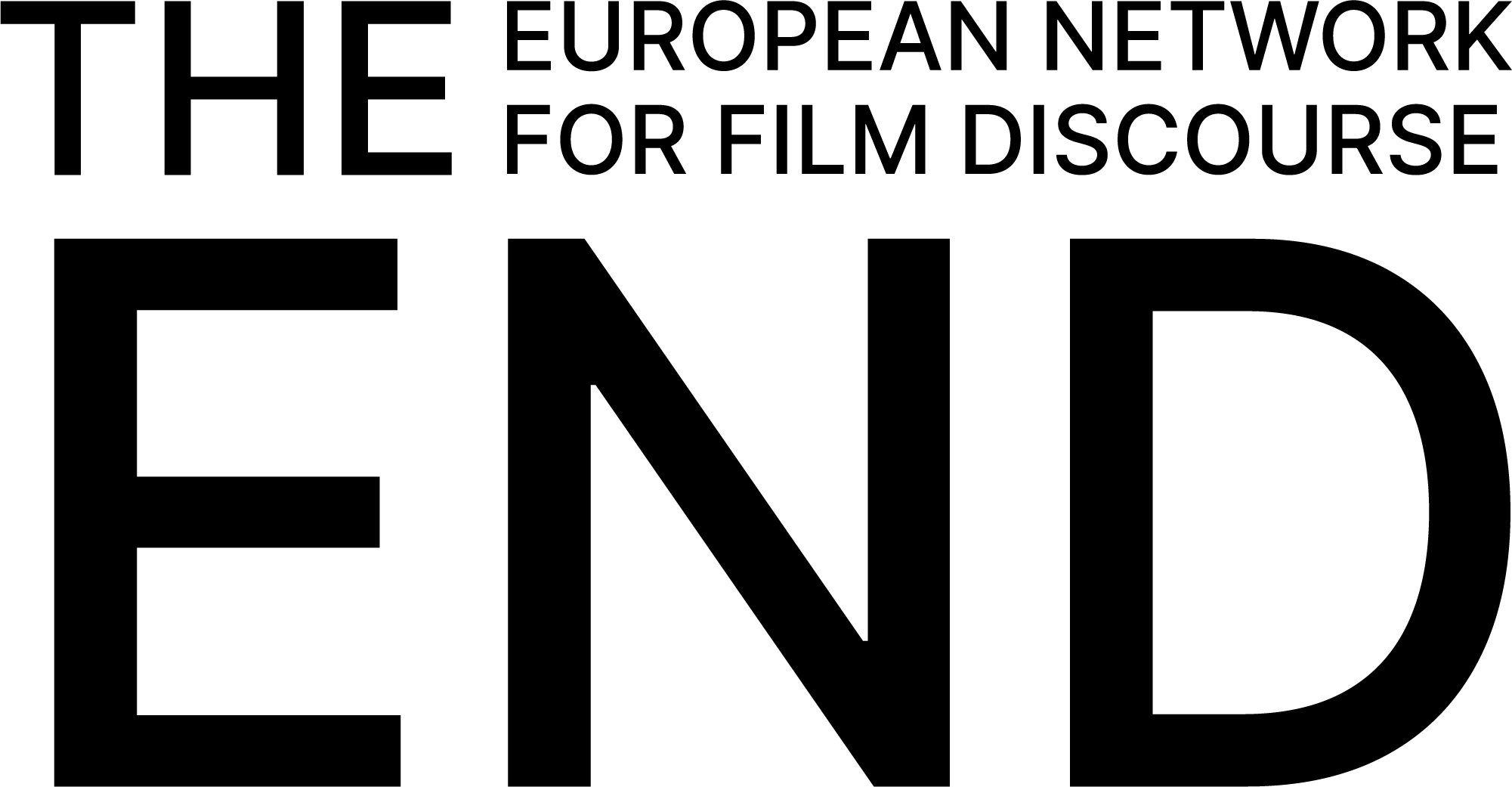Resistance as Ritual
Interview with Noor Abed
Amidst the most documented genocide in history, Noor Abed’s cinema presents Palestinian resistance as a repeated action, a haunting ritual.

The camera caresses the landscape in Palestinian artist and filmmaker Noor Abed’s cinema. Through long, shaky handheld shots, the jagged mountains near her home in Al-Jib and Jericho are rendered as tactile as the child who gently traces his nose along his father’s face. Women crawl like lizards up stairs that are carved into the rock, bodies pressed flat against the ground as if flesh was fusing with the rugged surface. “The land is what leads the movement,” Abed tells me, describing her process of choreographing for her films, “I don’t impose something that is out of the blue or abstract.”
I meet Abed online over Zoom where our faces sit side by side, bridging the distance between Portugal and Palestine. The smooth, disembodied images appear alien in contrast to the warm celluloid of her films, where the granularity of Super8 and 16mm teems with fleeting glitches and flashes of colour like spectral presences. Despite the digital flatness, Abed is animated and generous in her answers, quick to emphasise how she doesn’t create anything new so much as builds on existing Palestinian traditions: “I want to take the familiar and twist it, to make it a bit magical.”
Abed’s latest film, a night we held between (2024), screened at the 33rd Curtas Vila do Conde, programmed by Iranian filmmaker Maryam Tafakory as part of the Carte Blanche strand that accompanied a retrospective of Tafakory’s own films. Abed’s works have drawn much acclaim of late, her series of drawings and photographs of a stick being maneuvered by a dancer winning the 36th Ljubljana Biennale Grand Prize. An artist in residence at the Rijksakademie in Amsterdam (2022–24), she has since exhibited her works in major galleries across the world, such as the Museu Tapiès in Barcelona. Working at the intersection of performance art and film, she gravitates towards the intangible, preserving and remixing Palestinian culture, which endures in the face of nearly 80 years of Israeli occupation.
In a night we held between and its 2021 predecessor, our songs were ready for all wars to come, Abed’s choreography builds on embodied knowledge. “Death is a daily occurrence in Palestine, so mourning is a daily ritual.” She observes these everyday gestures in her community and hones in on certain movements, such as women touching faces at funerals. In a night, Abed translates this intimate act into a scene in which people trace each other’s faces with a tenderness that bleeds into sequential clips of a valley dotted with caves. “I try to merge the people with the landscape.”
“The people”, of course, are Abed’s own friends and family. “For me, filmmaking is communal; it has to be connected to the land and the people. It takes a village to make a film.” She scouts for locations with her long-time camera operator Hamoudi Trad and her father, and routinely includes local Palestinians in her films, who input their own ideas and improvise on set. “Movement is a basic tool of resistance in Palestine. Improvisation is a necessity, not a choice.”
Abed herself is no stranger to improvisation. For a night we held between, she wanted to film a traditional Palestinian dance performed by men at ceremonies, but the first attempts didn’t have the desired effect. Her third (which made the final cut) sees three women (Abed’s cousin and two friends) dancing around a fire. Bodies bend, arms propelling them towards the ground, then coming back up, a gesture repeated over and over in a trance-like state. In close-up, their faces look concentrated; shot from afar, the figures are out of focus and indistinct, no longer individuals but a single entity brought together through synchronous movement. “They are summoning another day to come, another night to hold.” I follow along from my hotel room in Vila do Conde until my arms tire and my back starts to hurt, the repetition inscribing new muscle memory into my body. The grainy images become blurrier as the dance goes on, augmenting their haptic quality. They are less a representation of dance than a surface of textures, giving rise to an embodied spectatorship where touch takes precedence over sight, and human connection prevails over mastery.
If our songs were ready for all wars to come takes place by and large above ground, draping cave entrances with shawls, a night we held between sees Abed delving into the subterranean and playing with chiaroscuros to create an otherworldly atmosphere. Filming from inside the caves, her camera lingers on holes through which the sun illuminates slivers of rock, shrouding the rest of the frame in pitch black. The various entries become portals between worlds, speaking to the historical use of caves by resistance fighters in the first Intifada (1987-1993), who used them as refuge from the Israeli army. “The area protects; it knows how to hold its secrets.” Abed similarly toys with opacity; no voiceover or text in her films provides context on the landscape or choreography. Instead, the long, unbroken shots force us to contemplate the skin of the cave and sit with its hauntedness.

© our songs were ready for all wars to come (2021, Noor Abed)
History lingers in Abed’s frames, but it does not weigh down on them. Like the procession of villagers who walk with their palms outstretched to support the underbelly of a rock, her choreography upholds resistance by sustaining community bonds. “Collective movement can lead us to a synchrony, and synchrony leads us to social action.” She tells me how villagers used to trick the Israeli soldiers into going the wrong way by spreading rumours. Her meticulous research into these historical methods of resistance makes its way into her films, as she replays and rewinds the movements, transfiguring motion into ritual. The term “resistance” has become ubiquitous in the art world, assimilated into copywriting and rendered meaningless through overuse. Yet the inverse is true in Abed’s films, where it is less a concept than a repeated action, concretised into reality through the synergy of the people.
The films’ various movement-rituals are held together by an eerie soundscape composed by musician Dirar Kalash. An echoing machinic hum is occasionally pierced by sharp synths, like the bristling scales of a metallic snake. Its mutating discomfort creates a dissonance between image and sound, preventing an uncritical immersion into these scenes. Rejecting an ethnographic consumption of Palestinian culture, Kalash’s sounds foreground what we cannot know, that which is inaccessible to the non-Palestinian viewer. Working with the hapticity of the celluloid, the audio fosters a sensorial proximity but keeps us at an epistemological distance, inviting us to intuit the knowledge embedded in the movement rather than interpret it intellectually.
In response to the ongoing genocide in Gaza, film festivals have started to program increasing numbers of Palestinian films. Curtas featured a focus strand on Palestinian filmmaker Mahdi Fleifel (To a Land Unknown, 2024), and Maryam Tafakory’s Carte Blanche placed a strong emphasis on Palestine, connecting Tafakory’s own films on Iranian censorship with the crackdown on voices speaking up about Palestine in the West. There’s an urgency to respond immediately to the situation, as reflected by films such as The Encampments (2025), a timely account of the pro-Palestinian student protests held across US universities in 2024 that nonetheless suffers from shoddy editing, likely a result of the filmmakers’ rush to get it released and screened. “We all have a responsibility to document what’s happening in Gaza,” says Abed, “But artists are not journalists. We have a job to translate imagination into a liberated future.” Moving beyond the immediacy of reaction, Abed’s works steadily construct a lexicon of embodied resistance, made possible only through years of research and lived experience.
I’m reminded of a scene in the Palestinian-Israeli documentary No Other Land (2024) where the Palestinian filmmaker Basel Adra lambasts his Israeli collaborator Yuval Abraham for his haste: “You want everything to happen quickly … as if you’ve come to solve everything in ten days, then go home.” The Nakba, the forced displacement of Palestinians from their land, began in 1948, and they have been fighting ever since; resistance unfurls across generations. Abed’s films remind us that it is only by collectively envisioning liberation–whether via armed struggle, dance, or jokes–that long-term structural change occurs.
As we witness the most documented genocide in history through a ceaseless stream of online content, it’s clear that no amount of plain evidence will lead to its end. “We should not take images for granted. As image-makers, we need to be thinking about how we can disrupt dominant narratives and work from the margins, to say things clearly and call things by their names.” It’s perhaps the very refusal of legibility in Abed’s films that speaks more articulately against apartheid than any explanatory text. Hers is a celluloid world of slow, steady rituals through which systems of domination are rendered absurd and powerless.
This text was developed during the European Workshop for Film Criticism #7—a tandem workshop set during Curtas Vila do Conde and FeKK – Ljubljana Short Film Festival—and edited by workshop tutor Leonardo Goi.
The European Workshop for Film Criticism is a collaboration of the European Network for Film Discourse (The END) and Talking Shorts, with the support of the Creative Europe MEDIA programme.




